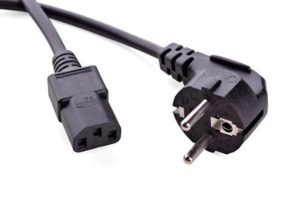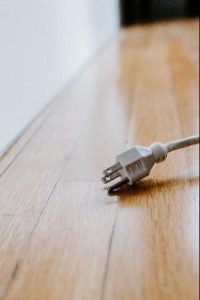

Difference Between C13 Power Cord and C14 Power Cord
Most household electronic devices have different power cords. You might have wondered what the difference between the various types of power cords is?
We discuss the differences between two standard power cords for household items: C13 Power Cord and C14 Power Cord. Let’s get started!
What is a Power Cord?
A power cord, also called a mains cable, line cord, or mains lead is an electrical cable that connects a device to the mains electricity supply via an extension or wall socket.

The power cord usually consists of three conductors: a black wire for the hot circuit, a white wire for neutral and a bare green wire, yellow/green or green/yellow striped wire for grounding (earth).
The primary purpose of a power cord is to carry current between the equipment and the electric outlet. A power cord can be used in any electrical device, irrespective of its voltage requirements, like 110 V or 220 V. Common examples include computers, monitors, printers, and servers.
There are many power cords, but today we will only discuss two of them: C13 and C14.
What is a C13 Power Cord?
A C13 Power Cord is a computer cord used to power a PC or monitor. It’s the typical PC power cord you’ll find attached to the back of your computer or monitor. You can also find these cords at the end of most desktop power supplies. They have three, as opposed to two, prongs (or pins) on either end of the cord and are often called kettle cords, “figure 8” cords, or IEC C13 power cords.
What is a C14 Power Cord?

The C14 power cord is an international standard for the connector end of a power cord. The connector has three round prongs with a larger ground pin than the other two. The pin arrangement of a C14 plug is identical to that of a C13 power cord. Therefore, the C14 plug will fit into a C13 socket and vice versa, but they are not interchangeable on every device.
Differences Between C13 Power Cord and C14 Power Cord
- Plug diameter
C13 power cords are generally used and come in different lengths from 6 to 25 feet. They also have a smaller plug diameter than C14 power cords, making them more vulnerable to damage when accidentally pulled or tripped over.
C14 power cords are thicker than C13 and have larger diameters because they carry more current than their counterparts. They are commonly used in industrial applications or on large appliances such as air conditioners, refrigerators, dishwashers, and clothes dryers.
2. C13 and C14 Power Cord Sizes
C13 and C14 power cords connect devices to a wall outlet or generator. The most common size of a C13 power cord is three feet long in large appliances like microwaves, refrigerators, air conditioners, and freezers.
The most common size of a C14 power cord is six feet long in computers and laptops, and other electronics such as printers and monitors.
3. The shape of the plug
The C13 power cord has a circular plug, while the C14 has an octagonal one. The shape of the plug determines how it will fit into your computer or device. The size of the plug is also essential as it will decide whether or not it will fit into your device.
4. Difference between C11, C12, C13 and C14 Power Cord
The C14 power cord has an octagonal shape to fit into many different devices. You can use it with computers, monitors, and other electronic devices that require a power source. The C11 and C12 power cords are similar in size and shape to the C13, but they are only used for specific devices like printers, monitors, and other electronics that require them.
5. The number of pins
A C13 power cord has two ends: one end is the standard AC (alternating current) plug, and the other end has three prongs—two flat ones at the top and a round one at the bottom. The round prong is called a “grounding pin” or a “third pin.”
The C14 power cord works precisely the same way as a C13 cord, but it has an extra third pin at both ends of its cable. So, if you’re using a device with both ends of the cord plugged into outlets, you might be able to use either type. However, one big difference is their length, which can vary depending on where you’re using them.
6. Voltage
The C13 connector is rated for up to 10 amps at 250 volts and is designed for use with appliances that run on either 120 or 240 volts. In contrast, the C14 connector is intended for use with devices that run on 230 volts. This means that the C14 connector is rated for up to 15 amps at 250 volts.
Both connectors are compatible with standard IEC-320-C13 receptacles and IEC-320-C14 inlets, but one cannot use them interchangeably on every device. So, if you need to replace your broken power cord, make sure you get the right one!
Conclusion
The C13 and C14 Power Cords are essential for electrical power distribution in modern societies. While their collective importance will not diminish anytime soon, it is helpful to understand how they function. This begins with understanding the differences between the two cords.

